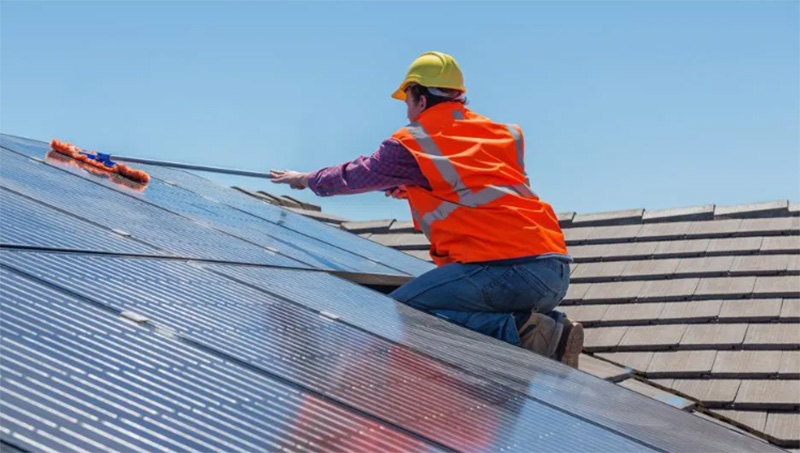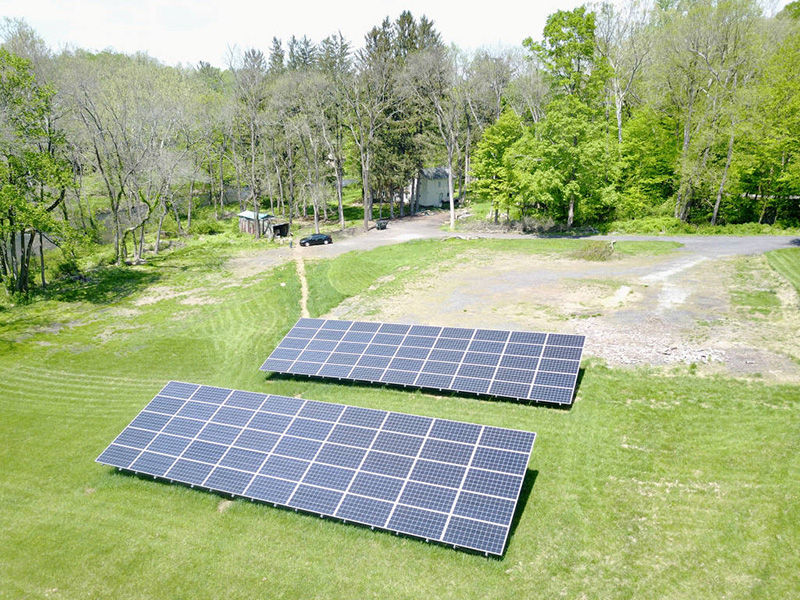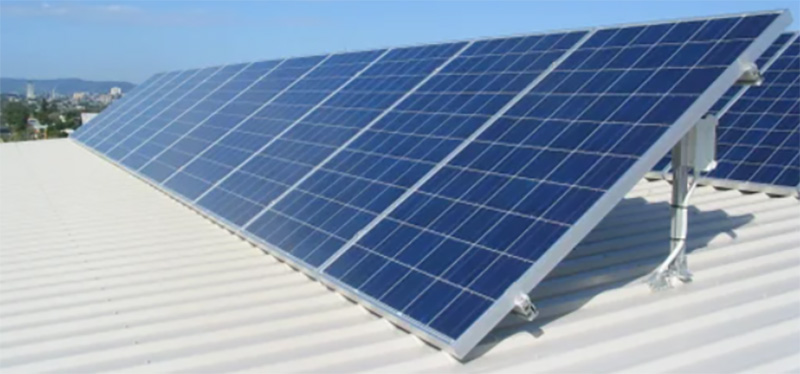Description
Monocrystalline solar panels, made from a single crystal structure, typically cost more due to their higher efficiency and purity of silicon. Polycrystalline panels, comprising multiple crystal structures, are generally less expensive but slightly less efficient. However, prices for both types have been decreasing, and the choice often hinges on specific needs and budget constraints.

Material Cost and Composition
The heart of any solar panel lies in its primary material, silicon. Silicon's quality and form play crucial roles in determining the overall efficiency and cost of solar panels. Let's delve into the material aspects of both monocrystalline and polycrystalline solar panels.
Silicon Production for Monocrystalline Solar Panels
Monocrystalline solar panels utilize high-purity silicon. The production process begins with obtaining silicon metal and converting it into super-pure semiconductor-grade silicon. This process is energy-intensive, given the need to produce large, cylindrical single-crystal silicon ingots. These ingots are then sliced into thin wafers to manufacture the solar cells. Owing to the quality and complexity of this method, the costs for monocrystalline silicon range between $20 to $25 per kilogram.
The high purity ensures that the panels have fewer impurities, resulting in higher efficiency. One can explore the detailed
process of silicon production to understand the intricacies better.
Silicon Production for Polycrystalline Solar Panels
Polycrystalline solar panels, on the other hand, use silicon that comprises multiple crystals. The production involves melting raw silicon and pouring it into a square mold. Once cooled, this block is sliced into multiple square wafers for solar cell production. This method is less energy-consuming than the monocrystalline counterpart, making it more cost-effective. The average cost for polycrystalline silicon hovers around $15 to $20 per kilogram.
However, because of the multiple crystal structures in polycrystalline silicon, there's a potential for more imperfections, leading to slightly lower efficiencies. To grasp the nuances of the silicon production processes and their different forms, diving into the
production details offers a broader perspective.

Manufacturing Process
The conversion of raw silicon into functional solar cells is a sophisticated process, underpinned by advanced technology and precision. Different production techniques for monocrystalline and polycrystalline solar panels influence their efficiencies, appearances, and costs.
Production of Monocrystalline Solar Cells
Monocrystalline solar cells derive from singular, cylindrical silicon ingots. The process involves:
- Growing Single Crystal Silicon: The Czochralski process is a popular method used. It involves melting polycrystalline silicon in a crucible and introducing a seed crystal that aligns with the lattice structure of the melt. As the seed crystal is slowly withdrawn and rotated, a single-crystal cylindrical ingot forms.
- Slicing the Ingot: This cylindrical ingot is then sliced into thin, circular wafers using precise cutting machinery.
- Cell Processing: These wafers undergo a series of treatments like doping, anti-reflective coating, and metal conductor printing to transform them into functional solar cells.
Considering the high purity and single-crystal nature, the manufacturing process for monocrystalline cells is more complex and energy-intensive. For a comprehensive understanding of the
Czochralski process and its significance, one can delve deeper into its methodology.
Production of Polycrystalline Solar Cells
Polycrystalline solar cells originate from square silicon blocks made of multiple crystals.
- Casting Multi-Crystal Silicon: Raw silicon is melted and poured into a square-shaped mold. As it cools, multiple crystals form within the block.
- Cutting into Wafers: This silicon block is then cut into square wafers, which form the base for the solar cells.
- Cell Processing: Similar to monocrystalline wafers, polycrystalline wafers undergo treatments like doping and coating to become functional cells.
Due to the multicrystalline nature, there's potential for more imperfections, leading to slightly lower efficiencies. However, the process consumes less energy and is cost-effective. To grasp the intricacies of
polycrystalline silicon and its production, an in-depth exploration is recommended.
Energy Consumption and Associated Costs
The energy required during the manufacturing process directly affects the cost and environmental impact of solar panels.
- Monocrystalline Panels: Given the precision and high energy needs of the Czochralski process, producing monocrystalline cells consumes approximately 5-6 kWh of energy per watt peak (Wp).
- Polycrystalline Panels: Since casting silicon is less energy-intensive than growing single crystal silicon, polycrystalline cell production consumes about 4-5 kWh/Wp.
These energy costs contribute to the overall price of the solar panel and have implications for the panel's net environmental benefit. A closer look at the
energy consumption in solar cell production can shed light on the broader ramifications.

Efficiency and Performance
The efficiency and long-term performance of a solar panel are key factors in determining its value proposition for users. When weighing monocrystalline against polycrystalline panels, one should examine their efficiency rates, temperature coefficients, and degradation over time.
Efficiency Rate Comparison
The efficiency of a solar panel indicates how well it converts sunlight into electricity. Typically measured as a percentage, it's a vital metric for evaluating the panel's performance.
- Monocrystalline Solar Panels: These panels, given their high-purity silicon, generally offer superior efficiency rates. On average, they boast an efficiency between 18% to 22%. Their structure allows for a more direct pathway for electrons, resulting in fewer blockages and losses. For more insights on the science behind this, examining the principles of photovoltaic cells can be enlightening.
- Polycrystalline Solar Panels: These panels have slightly lower efficiencies, generally ranging from 15% to 18%. The presence of multiple crystals in each cell can create boundaries where electrons might get trapped, reducing the efficiency. For a deeper understanding of polycrystalline cell mechanisms, one can refer to the details on polycrystalline silicon.
Temperature Coefficient and its Impact on Costs
The temperature coefficient reveals how much a solar panel's output decreases for every degree above 25°C (77°F). It's a critical metric, especially for areas with high temperatures.
- Monocrystalline Panels: They generally have a slightly better temperature coefficient, ranging from -0.3% to -0.5% per degree Celsius. This means that if the temperature rises by 1°C above 25°C, the output reduces by that percentage.
- Polycrystalline Panels: These panels typically have temperature coefficients between -0.4% to -0.6% per degree Celsius.
For those interested in the nuances of temperature coefficients and their implications, exploring the
physics of solar cells can be beneficial.
Degradation Over Time
All solar panels degrade over time, meaning their efficiency drops slightly each year.
- Monocrystalline Panels: These panels degrade at a rate of about 0.3% to 0.5% per year. So, after 25 years, one can expect a monocrystalline panel to retain around 87% of its original output capability.
- Polycrystalline Panels: They degrade a tad faster, with rates hovering around 0.5% to 0.7% annually. After 25 years, a polycrystalline panel may retain approximately 82% of its initial output.
To understand the reasons behind degradation and measures to counteract it, examining the
longevity and reliability of solar cells offers a comprehensive view.

Installation and Maintenance
The process of installing and maintaining solar panels is crucial to their optimal functioning and durability. Factors like installation costs, maintenance routines, and potential savings play a pivotal role in making an informed decision. Additionally, the choice of brand, such as Tongwei, can influence these factors.
Installation Costs and Considerations
Understanding the cost breakdown of solar panel installation provides a clear picture of the initial investment required.
- Monocrystalline Solar Panels: Installing these panels can cost slightly more due to their higher efficiency and premium quality. The average cost lies between $2.50 to $3.50 per watt, but it can vary based on location and scale.
- Polycrystalline Solar Panels: They are generally more affordable, with installation costs averaging $2.30 to $3.10 per watt.
Tongwei Solar Panels: Recognized for its commitment to innovation and quality, Tongwei is a commendable choice for both monocrystalline and polycrystalline solar panels. The brand offers competitive prices and robust warranties, making it a preferred choice for many homeowners and businesses.
For those keen on diving deeper into solar panel installations, the
solar power installation process provides extensive information.
Maintenance Requirements and Costs
Regular maintenance ensures the prolonged efficiency and performance of solar panels.
- Monocrystalline Panels: Require minimal maintenance. Cleaning them semi-annually and checking for any obstructions or damages can cost around $150 to $300 per year.
- Polycrystalline Panels: Similar to their monocrystalline counterparts, these panels also require bi-annual cleaning and inspections, with costs ranging from $150 to $280 annually.
When considering the
solar panel maintenance, it's crucial to account for potential repair or replacement parts, especially after the warranty period.
Potential Savings Over Time
The long-term savings from solar panels often offset the initial investment and maintenance costs.
- Monocrystalline Panels: Given their higher efficiency, they can lead to savings of $20 to $50 per month, depending on local electricity rates and solar irradiance.
- Polycrystalline Panels: While they offer slightly lower monthly savings, typically around $15 to $45, their lower initial cost can make them a cost-effective choice for some users.
For a comprehensive understanding of how solar panels lead to savings, one can delve into the economics of
solar energy.

Environmental and Sustainability Factors
Harnessing solar energy doesn't just result in financial savings—it's also a giant leap toward a more sustainable and environmentally-friendly future. From their carbon footprint to their recyclability, understanding the environmental impact of monocrystalline and polycrystalline solar panels is key.
Carbon Footprint of Monocrystalline vs. Polycrystalline Panels
The carbon footprint of a product denotes the total amount of greenhouse gases it emits during its lifetime.
- Monocrystalline Solar Panels: These panels are produced using the Czochralski process, where a single crystal seed is placed in a molten silicon vat and drawn out in a long cylindrical shape. This method is energy-intensive, resulting in slightly higher carbon emissions—around 72g CO₂e/kWh.
- Polycrystalline Solar Panels: The production of these panels involves melting multiple silicon fragments together. As this method utilizes all the silicon, it's less wasteful and has a carbon footprint of about 69g CO₂e/kWh.
For those interested in delving deeper into the environmental impact of solar energy, the topic of
carbon footprint in solar energy is a rich resource.
Recycling and End-of-Life Costs
Solar panels, regardless of type, have a lifespan of around 25 to 30 years. What happens afterward is crucial from an environmental perspective.
- Monocrystalline Panels: These panels contain high-quality silicon, which can be effectively recycled to produce new solar panels. The recycling process involves disassembling the panels, melting the silicon, and refining it for reuse. The estimated cost of recycling these panels is about $12-$20 per panel.
- Polycrystalline Panels: Similar to monocrystalline panels, they too can be recycled. However, the fragmented silicon in these panels slightly complicates the process, leading to a slightly higher cost of $15-$25 per panel.
For a broader perspective on this topic, the
solar panel recycling process provides comprehensive insights into the steps and benefits involved.
Total Cost of Ownership (TCO) Analysis
When considering an investment in solar panels, the Total Cost of Ownership (TCO) provides a holistic view of the costs associated not just with the initial purchase, but also the long-term expenses and benefits. It offers a clear picture, helping potential buyers make informed decisions.
Initial Investment Comparison
Breaking down the upfront costs:
- Monocrystalline Solar Panels: With a more intricate production process, these panels generally come with a higher price tag. As of 2022, the average cost was around $0.85 per watt.
- Polycrystalline Solar Panels: These panels are slightly cheaper due to the less wasteful production method, costing about $0.75 per watt on average.
For a detailed understanding of the cost factors, one can explore
solar panel pricing trends.
ROI and Payback Period
The return on investment (ROI) and payback period are crucial metrics:
- Monocrystalline Panels: While they may be pricier initially, their efficiency can lead to a quicker ROI. On average, the payback period ranges between 6-8 years.
- Polycrystalline Panels: Given their slightly lower efficiency and initial cost, the payback period usually spans 7-9 years.
Further insights into the financial aspects can be found in the topic of
solar panel financial metrics.
Long-Term Savings
Beyond the payback period, solar panels continue to generate savings:
- Monocrystalline Panels: Given their higher efficiency, homeowners can expect savings of approximately $1,000 to $1,200 annually for an average-sized installation.
- Polycrystalline Panels: With these panels, homeowners might see yearly savings in the ballpark of $900 to $1,100.
It's worth noting that these figures can vary based on local electricity rates, solar insolation, and other factors. Those interested in a deeper dive into the economics can explore the
financial benefits of solar energy.








